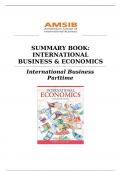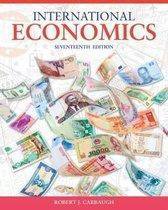SUMMARY BOOK:
INTERNATIONAL
BUSINESS & ECONOMICS
International Business
Parttime
,Table of Contents:
Chapter 1: The International Economy & Globalization..................2
Study Questions:............................................................................5
Chapter 2: Foundations of Modern Trade Theory: Comparative
Advantage.........................................................................................7
Chapter 3: Sources of Comparative Advantage..............................14
Chapter 4: Tariffs...........................................................................23
Chapter 5: Non - tariff Trade Barriers...........................................28
Chapter 9: International Factor Movements and Multinational
Enterprises..................................................................................... 32
Chapter 11: Foreign Exchange.......................................................36
Chapter 12: Exchange Rate Determination....................................41
Chapter 13: Exchange Rate Adjustments and the Balance – of -
Payments........................................................................................ 43
1
, Chapter 1: The International Economy &
Globalization
Economic interdependence:
The economy of one nation depends on the economy of other trading
partners in the world. This is reflected in the form of international
movements of goods and services, labour, business enterprise,
investment funds and technology. Therefore, business, labour, investors,
and consumers all feel the repercussions of changing economic
conditions and trade policies in other nations. As such, global economy
required cooperation on an international level to cope with the myriad
(veelvoudig) issues and problems and issues.
The federal reserve policy (FED):
A policy a country has when it suffers from the repercussions of economic
interdependence. Also, when domestic policies have spill over effects on
the economies of other countries.
Quantitative easing:
Purchasing large amounts of long – term securities in order to pump
additional money into the economy that would cause long – term interest
rates to fall.
Globalization:
Globalization is the process of greater interdependence among countries
and their citizens and consists of the increase interaction of product and
resource markets across nation. Globalization is political, technological,
cultural, and economic via:
Trade
Immigration
Foreign investment:
o international flows of goods and services, people, investments in
equipment, factories, stocks, and bonds.
Non – economic elements:
o Culture and environment.
Corporation stocks
Government securities.
Global manufacturing:
Is characterized by the geographical fragmentation of productive
processes and the offshoring of industrial tasks.
Agglomeration economies:
Rich country specialization in manufacturing niches that gained
productivity through agglomeration economies. Firms clustering
2
, together; some clusters produced the same product, and others were
connected by vertical linkages.
Openness ratio:
A rough measure of the importance of international trade in a nation’s
economy:
(Exports + Imports)
GDP
Globalization is important due to the following reasons:
International trade allows consumers to purchase that have not been
domestically produced.
Production can be separated from consumption, often by great
distances.
Individuals, firms, regions, and nations can specialize in the
production of things they do well and use the earnings from these
activities to purchase goods from other companies that are high – cost
producers.
Trading partners can produce a larger joint output and achieve a
higher standard of living, than would otherwise be possible.
The law of comparative advantage:
The citizens of each nation can gain by spending more of their time and
resources doing those things where they have a relative advantage.
If a good or service can be obtained more economically through trade, it
makes sense to trade for it instead of producing it domestically. The
central issue is how the available resources can be used to obtain each
good at the lowest possible cost. When trading partners use more of their
time and resources producing things they can produce best, they are able
to produce a larger joint output that provides the source for mutual gain.
The competitive process:
Competition is essential to both innovation and efficient production.
International competition helps keep domestic producers on their toes
and provides them with a strong incentive to improve the quality of their
products. Plus, international trade usually weakens monopolies as
monopoly producers face competition from foreign firms.
Open economies have more:
Competition
Firm turnover
Hight – cost domestic producers exiting the market, which leads to
productivity improvements for the industry.
New firms entering the market unless there are significant barriers.
Churning of the labour market.
Some workers might become unemployable due to the lack of
adequate education and training for new jobs that are being created as
a result of emerging firms.
Benefit from new technologies and other sources of economic growth.
3






